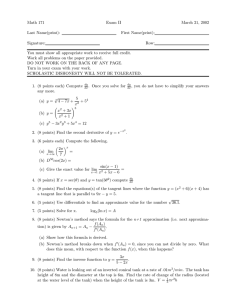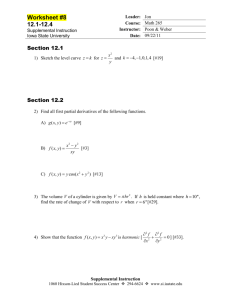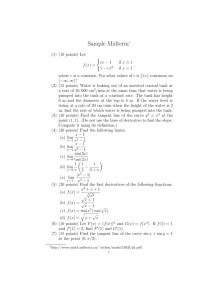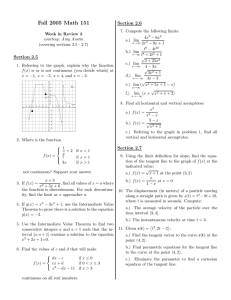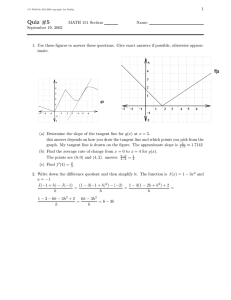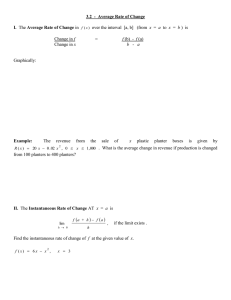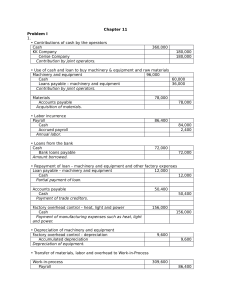Math 171 Exam II Solutions March 21, 2002 1. Compute
advertisement
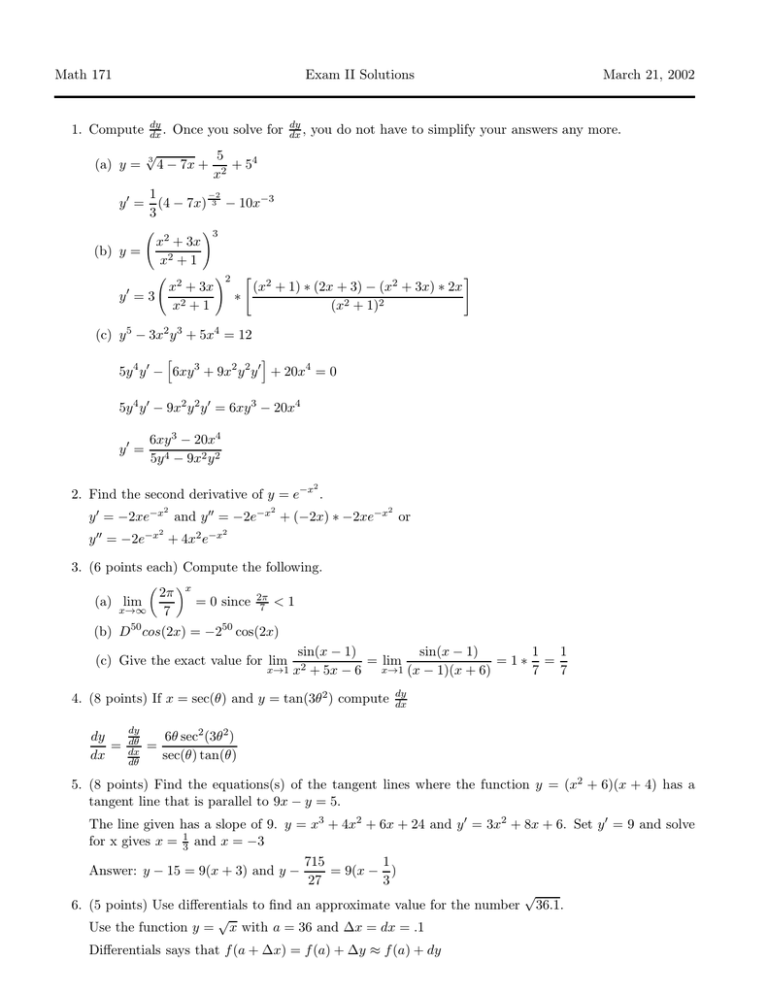
Math 171 Exam II Solutions 1. Compute (a) y = y′ = dy dx . √ 3 Once you solve for 4 − 7x + dy dx , March 21, 2002 you do not have to simplify your answers any more. 5 + 54 x2 −2 1 (4 − 7x) 3 − 10x−3 3 x2 + 3x x2 + 1 (b) y = !3 x2 + 3x x2 + 1 ′ y =3 !2 " (x2 + 1) ∗ (2x + 3) − (x2 + 3x) ∗ 2x ∗ (x2 + 1)2 # (c) y 5 − 3x2 y 3 + 5x4 = 12 h i 5y 4 y ′ − 6xy 3 + 9x2 y 2 y ′ + 20x4 = 0 5y 4 y ′ − 9x2 y 2 y ′ = 6xy 3 − 20x4 y′ = 6xy 3 − 20x4 5y 4 − 9x2 y 2 2 2. Find the second derivative of y = e−x . 2 2 2 y ′ = −2xe−x and y ′′ = −2e−x + (−2x) ∗ −2xe−x or 2 y ′′ = −2e−x + 4x2 e−x 2 3. (6 points each) Compute the following. 2π x = 0 since 2π 7 <1 x→∞ 7 (b) D 50 cos(2x) = −250 cos(2x) (a) lim sin(x − 1) sin(x − 1) 1 1 = lim =1∗ = 2 x→1 x + 5x − 6 x→1 (x − 1)(x + 6) 7 7 (c) Give the exact value for lim 4. (8 points) If x = sec(θ) and y = tan(3θ 2 ) compute dy = dx dy dθ dx dθ = dy dx 6θ sec2 (3θ 2 ) sec(θ) tan(θ) 5. (8 points) Find the equations(s) of the tangent lines where the function y = (x2 + 6)(x + 4) has a tangent line that is parallel to 9x − y = 5. The line given has a slope of 9. y = x3 + 4x2 + 6x + 24 and y ′ = 3x2 + 8x + 6. Set y ′ = 9 and solve for x gives x = 31 and x = −3 715 1 Answer: y − 15 = 9(x + 3) and y − = 9(x − ) 27 3 √ 6. (5 points) Use differentials to find an approximate value for the number 36.1. √ Use the function y = x with a = 36 and ∆x = dx = .1 Differentials says that f (a + ∆x) = f (a) + ∆y ≈ f (a) + dy now dy = 12 (x)−.5 dx = 1 √ dx 2 x .1 1 dy = 12 = 120 √ √ √ 36.1 = 36 + .1 ≈ 36 + dy = 6 + 7. (5 points) Solve for x. 1 120 log5 (ln x) = A (5A ) 5A = ln x which gives x = e 8. (8 points) Newton’s method says the formula for the n+1 approximation (i.e. next approximation) is f (An ) . given by An+1 = An − ′ f (An ) (a) Show how this formula is derived. First find the tangent line for the function at x = A1 . x = A1 is the initial guess for the solution. y − f (A1 ) = f ′ (A1 )(x − A1 ) now plug in a zero for y and solve for x. This solution is A1 . f (A1 ) A2 = x = A1 − ′ f (A1 ) You find A3 by repeating this procedure with A2 . f (An ) . If you continue in this fashion you get that An+1 = An − ′ f (An ) (b) Newton’s method breaks down when f ′ (An ) = 0, since you can not divide by zero. What does this mean, with respect to the function f (x), when this happens? The function has a tangent line that is horizontal at that point. 9. (8 points) Find the inverse function to y = swap the x and the y and then solve for y. y= 3x . 5 − 2x 5x 3+2x 10. (8 points) Water is leaking out of an inverted conical tank at a rate of .01m3 /min. The tank has height of 8m and the diameter at the top is 6m. Find the rate of change of the radius (located at the water level of the tank) when the height of the tank is 3m. V = 31 πr 2 h 6m 3m From the problem we know dV dt = −0.01 and h = 3 The other information is labeled on the picture. The relationship between the radius and the height is given by: hr = 38 or h = 83 r V = 31 πr 2 h = 13 πr 2 38 r = 89 πr 3 dV dr = 38 πr 2 dr dt note: if h = 3 then r = −.01 = 2 9 8 π 3 8 Solving for dr dt 9 8 dr dt gives dr dt = −.0009431m/min r 8m h
